Nabh4 Study guides, Class notes & Summaries
Looking for the best study guides, study notes and summaries about Nabh4? On this page you'll find 62 study documents about Nabh4.
Page 4 out of 62 results
Sort by
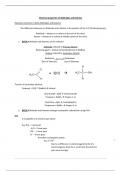
-
Chemical properties of Aldehydes and Ketones
- Exam (elaborations) • 45 pages • 2024
-
- $12.49
- + learn more
Chemical properties of Aldehydes and Ketones Reactions common to both Aldehydes and Ketones The difference between an Aldehyde and a Ketone is the position of the C=O (Carbonyl group). Aldehyde – always on a carbon at the end of the chain Ketone – Always on a carbon at middle carbon of the chain 1. BOTH Aldehydes and Ketones can be reduced Aldehyde reduced to Primary Alcohol Reducing agent = Sodium tetrahydroborate III (NaBH4) Ketone reduced to Secondary Alcohol Reduction Oxidisatio...
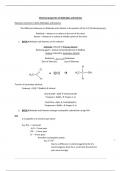
-
Chemical properties of Aldehydes and Ketones
- Exam (elaborations) • 45 pages • 2024
-
- $9.49
- + learn more
Chemical properties of Aldehydes and Ketones Reactions common to both Aldehydes and Ketones The difference between an Aldehyde and a Ketone is the position of the C=O (Carbonyl group). Aldehyde – always on a carbon at the end of the chain Ketone – Always on a carbon at middle carbon of the chain 1. BOTH Aldehydes and Ketones can be reduced Aldehyde reduced to Primary Alcohol Reducing agent = Sodium tetrahydroborate III (NaBH4) Ketone reduced to Secondary Alcohol ...
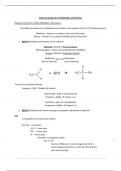
-
Chemical properties of Aldehydes and Ketones
- Exam (elaborations) • 45 pages • 2024
-
- $13.89
- + learn more
Chemical properties of Aldehydes and Ketones Reactions common to both Aldehydes and Ketones The difference between an Aldehyde and a Ketone is the position of the C=O (Carbonyl group). Aldehyde – always on a carbon at the end of the chain Ketone – Always on a carbon at middle carbon of the chain 1. BOTH Aldehydes and Ketones can be reduced Aldehyde reduced to Primary Alcohol Reducing agent = Sodium tetrahydroborate III (NaBH4) Ketone reduced to Secondary Alcohol Reduction Oxidisation ...
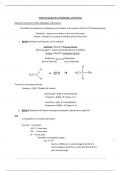
-
Chemical properties of Aldehydes and Ketones
- Exam (elaborations) • 45 pages • 2024
-
- $13.89
- + learn more
Chemical properties of Aldehydes and Ketones Reactions common to both Aldehydes and Ketones The difference between an Aldehyde and a Ketone is the position of the C=O (Carbonyl group). Aldehyde – always on a carbon at the end of the chain Ketone – Always on a carbon at middle carbon of the chain 1. BOTH Aldehydes and Ketones can be reduced Aldehyde reduced to Primary Alcohol Reducing agent = Sodium tetrahydroborate III (NaBH4) Ketone reduced to Secondary Alcohol Reduction Oxidisation ...
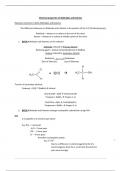
-
Chemical properties of Aldehydes and Ketones
- Exam (elaborations) • 45 pages • 2024
-
- $10.99
- + learn more
Chemical properties of Aldehydes and Ketones Reactions common to both Aldehydes and Ketones The difference between an Aldehyde and a Ketone is the position of the C=O (Carbonyl group). Aldehyde – always on a carbon at the end of the chain Ketone – Always on a carbon at middle carbon of the chain 1. BOTH Aldehydes and Ketones can be reduced Aldehyde reduced to Primary Alcohol Reducing agent = Sodium tetrahydroborate III (NaBH4) Ketone reduced to Secondary Alcohol Reduction Oxidisation ...
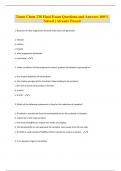
-
Tamu Chem 238 Final Exam Questions and Answers 100% Solved | Already Passed
- Exam (elaborations) • 25 pages • 2024
-
- $13.49
- + learn more
Tamu Chem 238 Final Exam Questions and Answers 100% Solved | Already Passed 1. Reaction of ethyl magnesium bromide with water will generate? a. ethanol b. ethane c. butane d. ethyl magnesium hydroxide e. a peroxide - b 2. Under conditions of thermodynamic control, product distribution is governed by: a. the relative stabilities of the products b. the relative energies of the transition states leading to the products c. the rate at which each product is formed d. a and b e. b and c ...

-
DAT Organic Chemistry Reactions
- Exam (elaborations) • 13 pages • 2023
-
- $18.99
- + learn more
--NO2 + Sn/HCl - Correct Answers>Clemmenson Reduction --NH2 1,2-addition conj double bonds + RMgX or LiAlH4 - Correct Answers>Nucleophiles attack the carbonyl directly. Strong nucleophiles: Gringards, NaBH4, LiAlH4 1. (2) esters CH3--C=O--OEt + NaOR, EtOH 2. H3O+ ketone + (ester) CH3--C=O--OEt + -OR + H3O+ --> - Correct Answers>Claisen Condensation enolate ion of one ester acts as nucleophile attacking another ester 1. NaOR, EtOH 2. H3O+ Anhydride for mixed 1. BH3/TH...
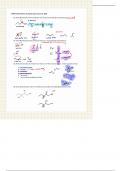
-
organic chemistry 2 1st exam notes
- Class notes • 16 pages • 2023
-
- $8.89
- + learn more
This section of notes covers all reactions, reagents, and stereochemistry from class before the first exam. Grignard reagents, SN2 reaction Markovnikov products, reductions, oxymercuration-demarcation, hydration, and acids are covered, just to name a few.
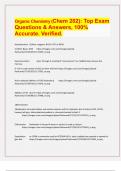
-
Organic Chemistry (Chem 202): Top Exam Questions & Answers, 100% Accurate. Verified.
- Exam (elaborations) • 4 pages • 2023
-
Available in package deal
-
- $7.99
- + learn more
Organic Chemistry (Chem 202): Top Exam Questions & Answers, 100% Accurate. Verified. Hydroboration 1)Other reagents: BH3 in THF or B2H6 2) Other Bases: KOH Oxymercuration Goes Through 3–memberd "mercurinium" ion. NaBH4 step removes the mercury. If –OH is used instead of H2O an ether will form. Acid–catalyzed addition of H2O (Hydration) Addition of HX Also HI 1)Bromination 2)Halohydrin Formation Water and alcohol solvents will for halohydrin but all others (CCl4, CHCl3, ...

-
Organic Chemistry 202 Synthetic Transformations, Top Exam Questions & answers, Rated A+
- Exam (elaborations) • 6 pages • 2023
-
Available in package deal
-
- $8.49
- + learn more
Organic Chemistry 202 Synthetic Transformations, Top Exam Questions & answers, Rated A+ reduction of an aldehyde or ketone to an alcohol LiAlH4 or NaBH4 H3O H2O lithium dialkyl cuprate reagent from an alkyl halide 4 Li metal CuI reduction of a nitro group to an amine Zn(Hg) HCl reduction of a benzyl carbonyl H2/Pd or Zn(Hg) HCl NAS (normal condition must be 1 EWG ortho/para to leaving group) nucleophile (–OH, –OR, R3N) benzyne reactions 1) NaOH 2) dilute acid benzyne...



